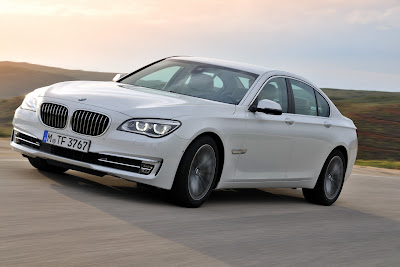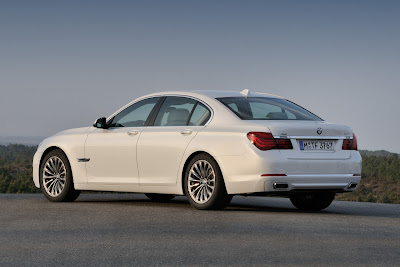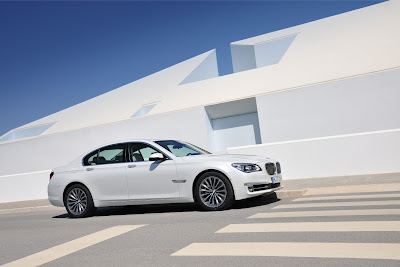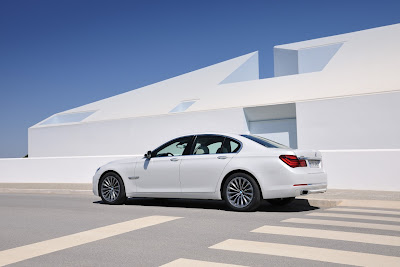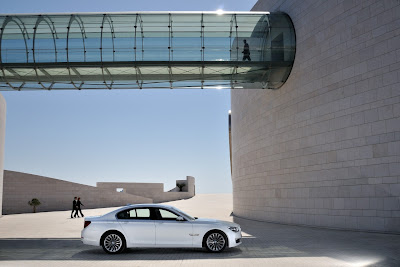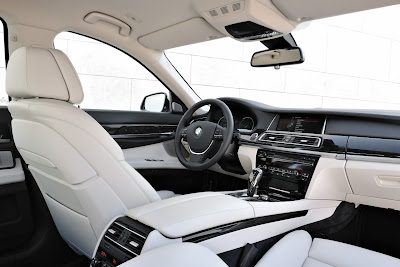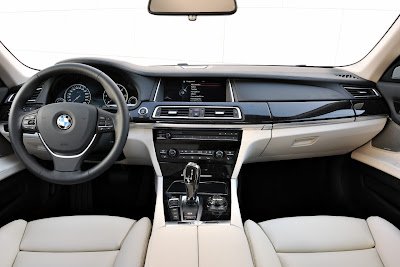If BMW’s philosophy for the 3-series is “the best sports sedan we can make,” the strategy for the 7-series may well be “just cram in everything we have.” But it’s been a long four years since the current 7 was introduced, and in the meantime BMW has acquired, invested in, developed, built, or invented so much more, er, stuff. It’s all headed for the 7-series this summer, along with some very subtle visual changes.
BMW 7-Series
New Engines for Everyone, Except the Billionaires
Other than the V-12–powered 760Li, every 7-series model will see significant upgrades to its powertrain. The 750i (and long-wheelbase 750Li) still use a twin-turbo 4.4-liter V-8, but BMW has added Valvetronic—its variable valve timing and lift system—to this engine. It helps pump up output from last year’s 400 hp and 450 lb-ft of torque to 445 and 480.
BMW 7-Series
The six-cylinder 740i and 740Li models also were sent to the operating room, emerging with the newer version of BMW’s turbocharged inline-six underhood. Power and torque stay at 315 hp and 330 lb-ft, but BMW says it expects the single-turbo N55 engine to improve upon the fuel economy of the outgoing twin-turbo N54. BMW has replaced virtually every N54 in its lineup with the N55 during the past year or so, but we haven’t noticed major fuel-economy improvements in the cars we have tested.
BMW 7-Series
Every 7-series model—yes, even the V-12 cars—now features an eight-speed automatic transmission in place of six-speed boxes. There are some other, less-headline-worthy upgrades: The eight- and six-cylinder cars now have standard stop-start systems to shut down the engine when the car is at a standstill. A self-flagellation system, called “Eco Pro,” has been added to the range of Driver Dynamics Control settings; it has the power to transform an ordinary 7-series into a Prius, strangling throttle response and shutting off the heating or air conditioning while stopped. Eco Pro also decouples the engine from the rest of the driveline when coasting at speeds between 30 and 100 mph. Finally, all-wheel drive now is available on the long-wheelbase version of the six-cylinder 7-series. In the past, it was offered just for the 750i and 750Li.
BMW 7-Series
The outgoing 7-series hybrid was not a winner. It was often unpleasant to drive, and was positioned more like Lexus’s LS600hL, aiming to give V-12 performance with V-8 consumption. BMW has binned the whole system for the 7, fortunately, and the new ActiveHybrid 7 seems to make more sense. This new gas-electric setup—available only in long-wheelbase configuration—is essentially the same as is used in the hybrid versions of the 3- and 5-series, pairing the N54 twin-turbo inline-six to an electric motor and an eight-speed automatic transmission. Combined output is 349 hp and 367 lb-ft of torque, down from the previous hybrid’s 455 hp and 515 lb-ft. Fuel-economy ratings aren’t out yet, but BMW says that in European testing the hybridized 7-series delivered a 14-percent improvement over a six-cylinder 740i.
BMW 7-Series
BMW 7-Series
BMW 7-Series
Suspension, Steering, and Everything Else
There are, quite frankly, so many mechanical modifications and new gadgets for the refreshed 7-series that we’d need to buy a new computer server to list the rest of them. Here are some selected highlights:
● Active Roll Stabilization now is standard on the 760Li and continues to be optional on the rest of the range; it aims to mitigate body roll through active front and rear anti-roll bars.
● A self-leveling rear air suspension is now standard across the board; such a suspension was previously available only on long-wheelbase eight- and twelve-cylinder models.
● Adaptive LED headlights are now available and come standard on the 760Li; these replace the adaptive xenon headlights.
● The iDrive navigation and infotainment system has been updated to the latest spec.
● BMW’s Parking Assistant now is available; this feature uses ultrasonic sensors to find a parking space large enough for the 7 and handles steering the car into the space. You know, if you’re afraid of parallel parking.
Subtle Cosmetic Changes
Excluding models with the full-LED headlights, the new 7-series looks at first glance the same as last year’s 7er. There are, however, some changes. The kidney grilles are revised and more upright, and BMW has performed a major upgrade by adding vertical slats. The lower part of the front fascia also has been redesigned, with a wide opening giving the 7 more of an anthropomorphic face.
BMW 7-Series
Inside the 2013 7-series, very little has changed. BMW describes the front seats as “more slender” than before and several new color and trim combinations find their way onto the options sheet. The roofline of the long-wheelbase models has been tweaked just slightly, which BMW says adds half an inch of headroom in the rear. A Bang & Olufsen sound system is now optional.
BMW 7-Series
How Much, and When?
The updated 7-series models should start arriving at dealers later this summer; the ActiveHybrid 7 will be available in early fall. Pricing hasn’t been announced yet, but figure on only modest increases from 2012 stickers, which started at $71,895 for a short-wheelbase, six-cylinder 740i and asked $86,195 for the least-expensive eight-cylinder car.
Articles Source : caranddriver
